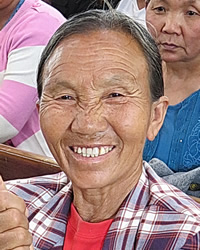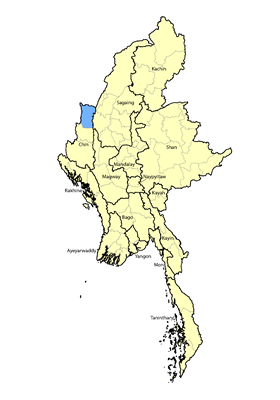The Siyin are also known as the Sizang, not to be confused with the Saizang people who live further northwest in northern Chin State. Linguistics say that the Siyin and Saizang speak separate languages. The Siyin have long been regarded as a distinct group in Myanmar, with the 1931 census returning a population of 3,486. The Siyin and other tribes in northern Chin State traditionally believed that the first people came after a gourd fell from the heavens. When it burst open a man and woman emerged to begin the human race.
Location: Numbering 11,000 people, the Siyin ethnic group inhabits 24 villages along the Siyin Valley in northern Chin State’s Tedim District. Their principal town is Khaikam, situated on the border between Chin State and the Sagaing Region. Siyin territory is bordered by several neighboring tribes, with the Vangteh and Tedim Chin to the north; Teizang to the west; and Ngawn and Zanniat to the south. The Tedim area has experienced heavy fighting during the current civil war, with 2024 proving a decisive turning point as the Burmese junta lost control.
Language: The Siyin language, which is part of the Northern Chin branch of the Tibeto-Burman linguistic family, enjoys widespread use and is believed to be most closely related to Tedim Chin and Zokam in Myanmar and to the Paite vernacular spoken across the border in northeast India.
Siyin legends go back to the dawn of history and include a story about a time their ancestors constructed a large tower that caused the separation of languages and customs as the people were scattered. Until the British subdued the area, the Siyin practiced head-hunting like many Naga and Tangshang tribes further north. The Siyin were also notorious slave traders, with the British discovering one family having 128 captive families. Punishment on those who tried to escape “was so severe that most captives became submissive before their masters resorted to cruelty.” After growing tired of years of fighting the fierce Siyin people the British resolved to “inflict on the Siyin such a crushing blow to not only cripple them for the future, but to terrify them into giving up their rebel leader and their captives.” Today, evidence of past conflicts are found scattered throughout the Siyin area, including the remains of Siallum Fort, which was built by the Siyin during the Battle of Siallum in 1889-90.
In the early 1890s, British Major F. M. Rundall said of the Siyin: “The Siyins are undoubtedly a brave and hardy race. It is their boast that one Siyin is worth five of any other men; and other tribes generally acknowledge their superior pluck…. The Siyins are easily moved to mirth and readily understand and appreciate a joke. They are by no means dull of apprehension, and they are a quick-witted, intelligent race that would readily take to education.”
All Siyin people practiced Animism before their conversion to Christ. Swedish-American missionary doctor Erik Hjalmar East and his wife Emily served among the Siyin from 1902 until poor health forced them to leave in 1910. Their six children are thought to be the first Westerners born in the Chin Hills. It was said of the Easts: “Their time in Burma was eventful. He baptized the first Northern Chin believers in Christ and established the first Baptist church among them. He also helped establish the first Christian organization, The Chin Baptist Association. They gave their love to the Chin people and the Chin's returned the love.” At the time of the 1931 census, 892 (one quarter) of Siyin people identified as Christians and the rest were animists.
The first Siyin converts were Thuam Hang and Pau Suan and their wives, who were baptized in 1905. The Siyin New Testament was published in 1999 using the Roman orthography, followed by the full Bible five years later. Before that time, most Siyin Christians used either Burmese or Tedim Chin Bibles, but having the Scriptures in their own language gave a boost to the faith of many believers. Today, an estimated 84 percent of Siyin people are Christians, with almost all belonging to conservative Baptist churches.
Scripture Prayers for the Siyin in Myanmar (Burma).
| Profile Source: Asia Harvest |











